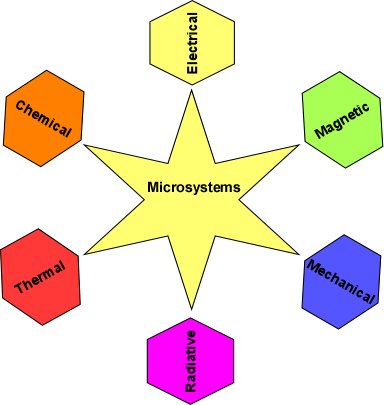|

|
EECE491E & EECE571E course page
Microsystems Design |  |
credits: 3
Structure
Lectures - Laboratories - Tutorials [hrs/week]: 3-0-0 + homework
assignments/projects
INSTRUCTOR
Dr. Edmond Cretu
Kaiser 3063
Phone: 604 827-4115
E-mail: edmondc at ece dot ubc dot ca
Office Hours: Wednesday 3:00-5:00pm (tentative)
Lectures
Monday, Wednesday, Friday, 9:00am-10:00am, McLeod
254
Course description
The course will introduce the students to MEMS-based microsystems, with
an emphasis on an integrated perspective and systematic
methods for the design and analysis of interdisciplinary systems at
microscale. A structured top-down design methodology encompassing
several levels (symbolic computation based on analytical modeling,
reduced order macromodeling, finite element analysis and layout
design) will be applied to design projects and case studies in the
field of MEMS (micro-electromechanical systems). Available design and
analysis tools (matlab/Simulink, MEMS Pro and Comsol Multiphysics) will
be used
during the project assignments. The course will also introduce
standard behavioral modeling languages (VHDL-AMS, Modelica) used in
current simulators.
calendar entryStructured design practices in Microsystems;
unified schematic representations across multiple energy domains; from
physical limitations in MEMS to their interface with electronics; apply
multiphysics design techniques to projects and case studies;
introduction to behavioral modeling languages for mixed analog-digital
system design.
Pre-requisites
None. The
course is offered to graduate students from various disciplines of
Engineering
and Applied Science, where the problem of designing interdisciplinary
systems
at microscale is expected to achieve a key role. An introductory
knowledge of
MEMS (e.g. as presented in EECE402) is helpful but not required.
course materials
Lecture notes and articles will be
provided in the classroom. Available e-books through UBC library portal
(e.g., [2,3] in the books list ) will be indicated to students.
Additional information sources are listed below.
ReferencesBooks:
- 1. Senturia, Stephen D [2002] “Microsystem Design,” Kluwer Academic
- 2. Allen, James [2005] “Microelectromechanical System Design,” CRC Press
- 3.
Korvink, J.G., Paul, O. [2006] “MEMS: a practical guide to
design, analysis, and applications”, Springer
- 4. Gad-el-Hak, Mohamed (ed.) [2005] “The MEMS Handbook 2nd ed.,” CRC Press
- 5. Liu, Chang [2006] “Foundation of MEMS,” Pearson Prentice Hall
- 6. Pelz, Georg [2003] “Mechatronic Systems. Modelling and simulation with HDLs,”, Wiley
- 7. Lobontiu,N , Garcia, E. [2005] “Mechanics of Microelectromechanical Systems,” Kluwer Academic
- 8.
Ashenden, P., Peterson, G.D., Teegarden, D.A. [2003] “The System
Designer’s Guide to VHDL-AMS,” Morgan Kaufman
- 9.
Verhoeven, C.J.M., van Staveren, et. al. [2003] “Structured Electronic
Design. Negative-Feedback Amplifiers,” Kluwer Academic
- 10. Leondes, Cornelius T. (ed.) [2006] “MEMS/NEMS Handbook. Techniques and Applications, vol.1-5 , Springer
Journals:
- 1. IEEE/ASME Journal of Microelectromechanical Systems
- 2. IOP Journal of Micromechanics and Microengineering
- 3. Microsystem Technologies, Springer
- 4. Sensors and Actuators A-Physical & B-Chemical, Elsevier
Conference Proceedings:
- 1. IEEE International Conference on Solid-State Sensors and Actuators (Transducers)
- 2. IEEE International Conference on Micro Electro Mechanical Systems (IEEE MEMS)
- 3. Modeling and Simulation of Microsystems (MSM)
- 4. Eurosensors
- 5. Solid-State Sensor, Actuator and Microsystems Workshop, (Hilton Head)
[tentative] Grading schemeFor the undergraduate students:Homework (mini-project): 20%
Midterm exam: 30%
Final exam: 50%
For the graduate students:Homework (will be provided for exercise without grading): 0%
Midterm exam: 20%
Final exam: 40%
Project: 40%
|